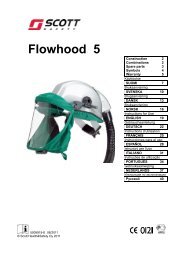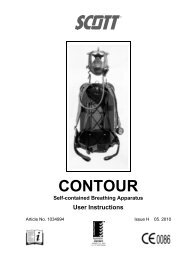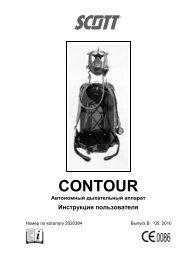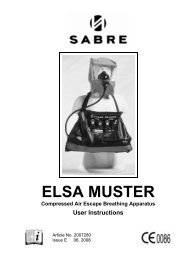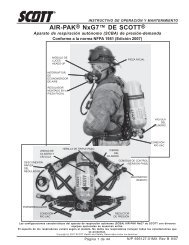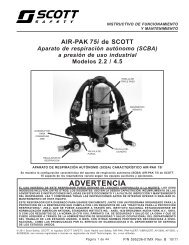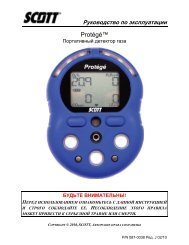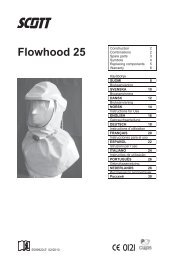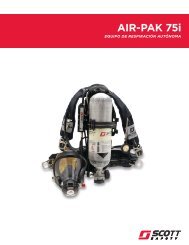7800 Controller - User Manual - Scott Safety
7800 Controller - User Manual - Scott Safety
7800 Controller - User Manual - Scott Safety
Create successful ePaper yourself
Turn your PDF publications into a flip-book with our unique Google optimized e-Paper software.
Model <strong>7800</strong> <strong>User</strong>s <strong>Manual</strong><br />
Revision E<br />
do not require discrete relays for each of the 48 alarm events (16 A1’s, 16 A2’s & 16<br />
A3’s). If discrete relays are needed for all 48 alarms, then six PCB’s are required.<br />
5 VDC power to the discrete relay option PCB’s is normally supplied from the MODEL<br />
<strong>7800</strong> <strong>Controller</strong> via the slender I 2 C cables connected to J2 and J3. However, I 2 C cables<br />
are limited in ability to carry this power further than a few feet without a significant<br />
voltage drop. Some MODEL <strong>7800</strong> applications with relays for all 48 alarms may require<br />
up to 6 boards. TB2 allows a heavier 5VDC power cable to be connected from terminals<br />
on the back of the MODEL <strong>7800</strong>front panel assembly, bypassing the I 2 C cable. A<br />
20AWG pair connected to only one of the several TB2’s is sufficient when these boards<br />
are in close proximity to each other.<br />
!<br />
All relays are rated at 5 Amp for 28 VDC and 250 ~VAC RESISTIVE loads.<br />
IMPORTANT: Appropriate diode (DC loads) or MOV (AC loads) snubber devices<br />
must be installed with inductive loads to prevent RFI noise spikes. Relay wiring<br />
should be kept separate from low level signal wiring.<br />
TB2 is used to supply external<br />
5VDC power to Alarm boards<br />
when they are mounted > 5<br />
feet from the controller. I2C<br />
cables provide 5VDC but losses<br />
occur with longer cable lengths.<br />
WARNING: Voltages exceeding<br />
6 volts may cause extensive<br />
damage to entire controller.<br />
Standard configuration has a 1<br />
minute POWER ON time delay<br />
preventing relay actuation during<br />
the delay. SB1 increases delay<br />
time to 8-minutes. SB2 removes<br />
all time delay.<br />
Wire TO CPU<br />
5VDC if > 5’<br />
from controller<br />
5VDC ONLY!<br />
+<br />
-<br />
TB2<br />
S1 controls if discrete relays are tripped by<br />
A1, A2, or A3 alarms for Ch’s 1-8 or 9-16.<br />
See Chart.<br />
ASSY# 10-0195 8-CH DISCRETE RELAY<br />
8-CH CHART<br />
WITH 8 RELAYS: S1-2=Ch9-16 A1<br />
S1 selects Ch’s 1-8 S1-3=Ch9-16 A2<br />
or 9-16 for A1, A2 & S1-4=Ch9-16 A3<br />
A3 (Flt) See chart---> S1-5=Ch1-8 A1<br />
0 S1-6=Ch1-8 A2<br />
S1-7=Ch1-8 A3<br />
J2<br />
U3<br />
Q2<br />
SB1 SB2<br />
S1<br />
U1<br />
U2<br />
J3<br />
ZONE JP4<br />
JUMPERS<br />
Install<br />
vertically<br />
to create<br />
Ch. zones<br />
Ch1<br />
Ch2<br />
Ch3<br />
Ch4<br />
Ch5<br />
Ch6<br />
Ch7<br />
Ch8<br />
J2 & J3 are interchangable I2C<br />
connectors used to add option<br />
PCB assemblies to the controller.<br />
JP4 allows “zoning” of adjacent<br />
channel alarms. All zoning jumpers<br />
are placed vertically. Dwg. exhibits<br />
channels 1-4 and channels 5-7<br />
creating 2 zones. All relays in a zone<br />
switch together. Unused jumpers<br />
may be stored horizontally.<br />
NO C NC NO C NC NO C NC NO C NC<br />
CH1/9 CH3/11 CH5/13 CH7/15<br />
TB1<br />
NO C NC NO C NC NO C NC NO C NC<br />
CH2/10 CH4/12 CH6/14 CH8/16<br />
5 amp form C dry contacts. Contacts are unfused. Switching<br />
inductive loads may create high levels of RFI. Use appropriate<br />
“RFI Snubbers” on inductive load devices.<br />
8 Channel Discrete Relay Option #10-0195<br />
Figure 3.4<br />
<strong>Scott</strong> <strong>Safety</strong><br />
24<br />
087-0021 Rev F





